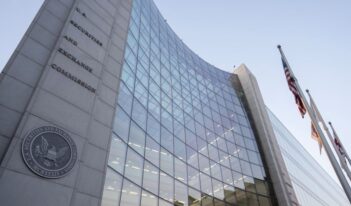
Scholars analyze the history of Supreme Court securities law jurisprudence to predict what lies ahead.
A political war is brewing over the future of American corporate and securities laws.
The head of the federal securities regulator, Gary Gensler, has announced plans to overhaul regulation of the U.S. stock market, sparking contentious debate among lawmakers and prompting threats of litigation by industry executives.
Some experts predict a dramatic increase in securities litigation, suggesting that this regulatory war may be fought in the courts for years to come.
To predict who will likely win that war, law professors Adam C. Pritchard and Robert B. Thompson look to the past. They argue that an analysis of the Court’s past approach to securities law and SEC authority can inform expectations for the future.
Pritchard and Thompson identify patterns within the U.S. Supreme Court’s securities jurisprudence starting with the inception of the federal securities laws and founding of the U.S. Securities and Exchange Commission (SEC) in the 1930s. They pinpoint five judicial shifts over the next nine decades: from restrictive oversight of regulation, to broad deference to agency expertise, to expansive purposivism, to strict constitutionalism, and, finally, to indifference.
They claim that SEC paved the way for regulatory change in the past, and that the Court’s variably expansive and restrictive approaches to securities regulation are indicative of a greater struggle between federal and state power.
Pritchard and Thompson’s historical analysis begins in the 1930s, examining the shift from a Court hostile to federal economic regulation to one that enabled the expansion of SEC authority. Although this shift was necessitated by the Great Depression, they claim it was enabled and perpetuated by President Franklin Delano Roosevelt’s transformation of the Supreme Court. A series of Supreme Court retirements allowed the Roosevelt Administration to appoint eight new justices, they explain, each with hands-on experience drafting or advocating the adoption of New Deal securities laws. These Justices led the Court in steady deference to SEC expertise and expansive interpretation of the securities laws into the 1960s, Pritchard and Thompson find.
They suggest that a 1960s shift into expansive purposivism pushed further in this direction. The Court not only continued an expansive interpretation of federal securities statutes but went beyond them to find new remedies for investors. Pritchard and Thompson argue that the Court permitted SEC to fill in statutory gaps to attack insider trading and overtake areas of state authority, even extending implied federal rights of action to shareholders in the case of Superintendent of Ins. v. Bankers Life & Cas. Co.
But this expansive approach was replaced abruptly by strict constitutionalism and a reinforcement of state authority in the 1970s and 1980s, Pritchard and Thompson claim. They urge that this shift was driven by Justice Powell, eager to reign in SEC expansion after practicing securities law for decades. Justice Powell led the Court to take on many securities cases and undo most of the regulatory expansion of the 1960s, moving the majority away from SEC deference and toward restriction by the time of his retirement.
Pritchard and Thompson contend that since Justice Powell left the bench in 1987, the Court has shifted into directionless indifference. The number of securities cases before the Court has dwindled, they claim, and the Court’s majority is perpetually meandering between an expansive and restrictive approach to regulation.
Pritchard and Thompson compare past and present to inform their predictions for the future of securities regulation.
They argue that securities law no longer serves as a battleground for regulatory change or struggles between federal and state power. Furthermore, SEC is no longer the regulatory trailblazer it once was. Accordingly, they predict that the dramatic shifts of the past are unlikely to recur, and the current trend of judicial indifference will likely continue for the foreseeable future.
Pritchard and Thompson point to the 2008 Great Recession to support their prediction. The Great Recession did not spark a regulatory movement comparable to the overhaul following the Great Depression, even though it was a comparable financial crisis. SEC failed to anticipate and prevent the Great Recession, and the agency has not led any major enforcement initiative related to new regulations that emerged following the crisis. Even in the face of crisis, securities regulation did not take center stage—something Pritchard and Thompson argue is not changing anytime soon.
Additional reasons for a continuation of judicial indifference lie in the current political landscape and judicial nomination process, Pritchard and Thompson claim. They argue that congressional gridlock has resulted in fewer pieces of securities legislation, leading to fewer securities cases in front of the Court. They also suggest that most of today’s judicial nominees come from the federal appellate courts, causing an absence of Justices with a background or interest in securities regulation, as was the case with the New Deal Justices and later with Justice Powell.
According to Pritchard and Thompson, these factors result in the diminishing importance of securities law, a slowing of securities litigation, and a judiciary less interested in reforming securities regulation.
Although they maintain that judicial indifference is most likely to persist, Pritchard and Thompson speculate that securities litigation stemming from Chevron questions or a future rulemaking imposing stricter corporate governance requirements could provoke another shift in the Court’s approach.
Pritchard and Thompson claim that securities law could cause another major regulatory shift if a securities case made its way to the Court on a Chevron challenge, where the Court could abandon its traditional deference to the agency’s interpretation of its statutory authority. They argue that the statutory interpretation and deference issues presented by Chevron are issues the Court has historically wrestled with in the securities law context, notably in the Chenery I and Chenery II decisions.
They allege that the Court’s conservative majority appears eager to revisit the Chevron doctrine, and a challenge to an SEC rulemaking might give them that opportunity. Such a challenge might arise from a corporate governance rulemaking or a proposal to mandate corporate social responsibility.
Pritchard and Thompson’s predictions were published in 2021, before the SEC announced sweeping regulations and was met with litigation threats. If SEC rulemaking does spark a dramatic increase in securities litigation as predicted, Pritchard and Thompson’s Chevron speculations could become a reality.



